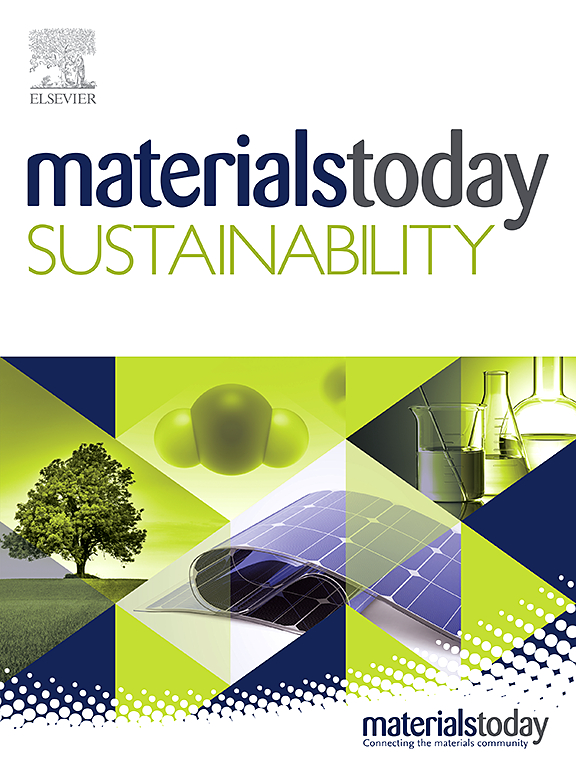Perovskite photovoltaics with cutting-edge strategies in 2D TMDs-based interfacial layer optimization
IF 7.1
3区 材料科学
Q1 GREEN & SUSTAINABLE SCIENCE & TECHNOLOGY
引用次数: 0
Abstract
One practical solution for effective solar energy conversion is the use of perovskite photovoltaics (PV). Nevertheless, issues like hysteresis, instability, and short device lifetimes have restricted their practical use. As interfacial layers, two-dimensional transition metal dichalcogenides (TMDs) are quite different from metal oxides and small molecules. Optical and electronic properties can be improved by adjusting layers or applying strain on TMDs, which have a layered structure with direct bandgaps that is atomically thin. High carrier mobilities and distinct van der Waals interactions with neighboring layers are also supported by them. Charge transport capabilities; on the other hand, small molecules are typically processed using solution-based techniques and provide discrete energy levels. Interfacial layers facilitate smooth charge transport, which is advantageous to perovskite absorber layers. Much attention has been paid to the unique properties and compatibility of 2D TMDs with perovskite solar cells. The use of 2D TMDs materials as interfacial layers in perovskite photovoltaics (PVs) is reviewed in this review, with particular attention paid to their roles as electron transport layers (ETLs) and hole transport layers (HTLs). We first describe the main challenges faced by PSCs and how interfacial layers offer workable solutions. We also study the ways in which these layers improve robustness of the device, reduce hysteresis effects, and increase charge extraction efficiency. We consolidate information regarding the potential of two-dimensional (2D) materials to address important concerns concerning PSCs, thereby advancing the development of dependable and effective PVC devices for real-world solar energy harvesting applications. We do this by providing a comprehensive overview of recent research.
利用基于二维 TMD 的界面层优化的前沿战略开发 Perovskite 光伏技术
有效转换太阳能的一个实用解决方案是使用过氧化物光伏技术(PV)。然而,磁滞、不稳定性和设备寿命短等问题限制了它们的实际应用。作为界面层,二维过渡金属二掺杂物(TMDs)与金属氧化物和小分子有很大不同。TMD 具有原子级薄的直接带隙的层状结构,通过调整层或对其施加应变,可以改善其光学和电子特性。它们还支持高载流子迁移率以及与邻近层之间明显的范德华相互作用。电荷传输能力;另一方面,小分子通常使用基于溶液的技术进行处理,并提供离散能级。界面层可促进电荷顺利传输,这对包晶体吸收层来说非常有利。二维 TMD 的独特性质以及与包晶体太阳能电池的兼容性受到了广泛关注。本综述回顾了二维 TMDs 材料作为界面层在包晶光伏(PV)中的应用,尤其关注它们作为电子传输层(ETL)和空穴传输层(HTL)的作用。我们首先介绍了 PSCs 面临的主要挑战,以及界面层如何提供可行的解决方案。我们还研究了这些层改善器件稳健性、减少滞后效应和提高电荷提取效率的方法。我们整合了有关二维(2D)材料潜力的信息,以解决有关 PSC 的重要问题,从而推动可靠、有效的 PVC 器件的开发,用于现实世界中的太阳能收集应用。为此,我们对最新研究进行了全面综述。
本文章由计算机程序翻译,如有差异,请以英文原文为准。
求助全文
约1分钟内获得全文
求助全文
来源期刊

Materials Today Sustainability
Multiple-
CiteScore
5.80
自引率
6.40%
发文量
174
审稿时长
32 days
期刊介绍:
Materials Today Sustainability is a multi-disciplinary journal covering all aspects of sustainability through materials science.
With a rapidly increasing population with growing demands, materials science has emerged as a critical discipline toward protecting of the environment and ensuring the long term survival of future generations.
 求助内容:
求助内容: 应助结果提醒方式:
应助结果提醒方式:


